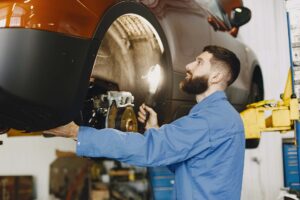Automobile safety has significantly advanced since the inception of automobiles in the 19th century, evolving from basic seat belts to sophisticated Electronic Stability Control systems. As we embark on a journey through the history and future of vehicle safety, it’s crucial to understand how these technologies have transformed our driving experiences. Join us as we explore the critical role these innovations play.
What Are the Basics of Automobile Safety?
Understanding the fundamentals of vehicle safety is essential for anyone who gets behind the wheel. If living without a car isn’t an option for you, then you need to find out all about the auto safety history and the core elements that make modern models more reliable than ever.
Automobile safety encompasses the research and application of vehicle design, construction, equipment, and regulatory standards to reduce the frequency and impact of accidents involving motor vehicles. It also extends to broader aspects like the design of roads for traffic safety. One key element of this field is conducting crash tests to evaluate vehicle safety.
Historical Milestones in Vehicle Safety
The history of auto safety has been marked by significant milestones that have greatly reduced the risks associated with driving. Of course, the first vehicle ever made didn’t have all the safety features that modern cars have. The invention of seat belts, a simple yet life-saving feature, revolutionized safety standards. Airbags further enhanced protection, deploying in milliseconds during a collision to cushion occupants from impact.
A practical feature like a spare tire is a must, of course, you need to check the tire pressure. Another essential advancement was the development of anti-lock braking systems (ABS), which prevent wheel lockup during emergency braking, ensuring better vehicle control. More than 60% of drivers with vehicles equipped with ABS have reported instances where they felt the ABS was instrumental in preventing a collision.
The Role of Vehicle Safety in Everyday Commuting
Vehicle safety plays a vital role in everyday commuting, especially in scenarios like long-distance relocations where the risk of accidents can be higher due to extended periods on the road. Advanced safety features in modern vehicles, such as electronic stability control and lane departure warnings, actively work to prevent accidents.
These road safety innovations protect not only the driver but also passengers and other road users, making everyday travel safer. For those who are long-distance commuting, safety features provide peace of mind, knowing that the vehicle is equipped to handle various road conditions and unexpected situations.

Advanced Safety Features in Modern Vehicles -How Has Car Safety Improved Over the Years
The landscape of automobile safety has dramatically evolved, leading to the integration of advanced safety features in modern vehicles. These innovations are not just enhancements but are crucial in shaping a new era of driving safety. Let’s check how cutting-edge technology is being employed in today’s four-wheelers to offer unprecedented levels of protection and assistance to drivers.
Nearly every vehicle accident is attributable to human mistakes, issues that can be mitigated through Advanced Driver Assistance Systems (ADAS). ADAS aims to diminish fatalities and injuries by lowering the frequency of car crashes and lessening the severity of those that are unavoidable.
The Advent of Autonomous Driving
Considering the car safety history, autonomous driving technology represents a monumental shift in road safety, introducing self-driving four-wheelers that could revolutionize how we navigate our streets. These vehicles, equipped with sensors, cameras, and advanced algorithms, can make real-time decisions, potentially reducing human error, which is a leading cause of accidents.
The impact of autonomous driving could be significant, offering safer, more efficient, and accessible transportation options. As this technology advances, it promises not only to alter our driving experiences but also to enhance overall road safety, potentially reducing traffic accidents and fatalities. In fact, self-driving vehicles hold the promise of decreasing fatalities from accidents by as much as 90%.
Smart Safety Features for Urban and Interstate Driving
Comparing the automotive safety history, modern four-wheelers are increasingly equipped with smart driving features designed for both urban environments and interstate travel. These technologies collectively work to enhance driver awareness and reaction times, significantly contributing to safer urban and interstate driving experiences.
Adaptive Cruise Control
This feature automatically adjusts the vehicle’s speed to maintain a safe distance from the car ahead, which is especially useful in varied traffic conditions.
Lane-Keeping Assist
Lane-keeping assist helps drivers stay within their lanes, reducing the chances of accidents due to unintentional drifting. This system reduces car accidents by up to 21%.
Collision Avoidance Systems
This system actively monitors the vehicle’s surroundings and can autonomously apply brakes in the face of an impending collision.
Choose Some of the Safe Moving Vehicles
When planning a relocation, selecting a vehicle that guarantees the highest level of safety is crucial. So, if you’re wondering whether to ship a four-wheeler cross-country or drive, you first need to consider some crucial factors. It’s because the chosen vehicle for moving should be safe and reliable. It’s not just about comfort and space – safety ratings and features play a significant role in ensuring your journey is as safe as it is smooth.
Car Safety Ratings and What They Mean for You
Safety ratings are an invaluable tool in assessing a vehicle’s safety credentials, especially when preparing for a relocation. These ratings, provided by organizations like the National Highway Traffic Safety Administration (NHTSA) and the Insurance Institute for Highway Safety (IIHS), evaluate various safety aspects.
The first one is crashworthiness, rollover safety, and the effectiveness of safety features. A high safety rating indicates a vehicle’s superior ability to protect its occupants in the event of an accident. When selecting a vehicle for moving, it’s essential to understand and compare these ratings, as they provide an objective measure of the vehicle’s safety performance under different conditions.

Top Vehicles for Safety and Reliability
For those prioritizing safety and reliability in their relocation vehicle, certain models stand out. As one of the drivers’ responsibilities, you have to pick the four-wheeler that will not only be safe and reliable but the most comfortable for your driving needs. Here are some models that consistently rank high in safety assessments, making them ideal candidates for anyone seeking a dependable and secure vehicle for their relocation journey.
| Vehicle Model | Key Safety Features |
| Volvo XC90 | Robust safety features and advanced driver assistance systems |
| Subaru Outback | All-wheel drive and EyeSight driver assist technology |
| Honda CR-V | Collision mitigation braking and adaptive cruise control |
| Toyota RAV4 | Collision mitigation braking and adaptive cruise control |
The Future of Automobile Safety and Relocation
As we look toward the horizon of automobile innovation, the future of vehicle safety holds exciting and transformative possibilities, especially in the context of relocation. This being said, let’s explore the emerging technologies and trends set to redefine vehicle safety standards, highlighting how they could significantly impact the ease and security of long-distance moves.
Upcoming Innovations in Vehicle Safety
The next wave of vehicle safety innovations promises to integrate more sophisticated technologies, like augmented reality (AR) dashboards and Vehicle-to-Everything (V2X) communication. AR dashboards will project crucial information onto the windshield, allowing drivers to stay informed without diverting their attention from the road. This feature is especially useful while driving at night and all of your focus should be on the road.
V2X communication enables vehicles to interact with various elements in their environment, such as traffic signals and other vehicles, to improve situational awareness and prevent accidents. These advancements are poised to offer a more interactive, informed, and proactive approach to vehicle safety, marking a significant leap forward in the way we perceive and interact with our vehicles.
How Future Car Technologies Might Ease Relocation Stress?
The integration of advanced safety technologies in vehicles could greatly help in overcoming driving anxiety and alleviate the stress associated with long-distance relocations. For instance, enhanced navigation systems could predict and avoid traffic congestion, making the journey more efficient.
Autonomous driving features might allow drivers to rest during long stretches of the trip, reducing fatigue and the risk of accidents caused by tiredness. Improved safety features like advanced collision avoidance systems will provide an additional layer of security, ensuring peace of mind for those transporting valuable possessions.
These state-of-the-art safety technologies do more than prevent accidents. They play an essential role in transforming the entire driving experience into one that is smoother, safer, and significantly less fraught with driving-related stress and anxiety.

Safeguarding Your Journey: The Paramount Role of Vehicle Safety in Relocations
The importance of automobile safety, particularly in the context of relocation, cannot be overstated. This exploration through the evolution and future of vehicle safety technologies underscores how crucial it is to prioritize safety features when selecting a vehicle for moving. From the basic safety essentials to advanced innovations, each aspect plays a vital role in ensuring a secure and stress-free relocation experience.
As we move forward into an era of even more sophisticated safety technologies, let this be a reminder to always place safety at the forefront of our choices, ensuring that our journeys, whether short commutes or long-distance relocations are as secure as they are successful.
Frequently Asked Questions About Automobile Safety
How Do Safety Features in Cars Affect Insurance Costs During Relocation?
Safety features in cars can lead to lower insurance costs during relocation. Insurance companies often offer discounts for vehicles equipped with advanced safety features like automatic braking or lane departure warnings, as these technologies reduce the risk of accidents and claims.
Can Advanced Safety Features Really Reduce the Stress of Moving?
Yes, advanced safety features can significantly reduce the stress of moving. Features like adaptive cruise control, rear-view cameras, and blind-spot monitoring offer added convenience and protection, making the driving experience during relocation more comfortable and secure.
What Are the Most Important Safety Features to Look For in a Family Vehicle for Relocation?
For a family vehicle, safety is a must and some of the key features include adaptive cruise control, lane-keeping assistance, automatic emergency braking, and comprehensive airbag systems. These features provide enhanced protection for all passengers and are particularly beneficial in long-distance relocations.
How Will Future Automobile Safety Technologies Change the Moving Industry?
Future automobile safety technologies, such as autonomous driving and V2X communication, will revolutionize the moving industry. They will improve efficiency, reduce the incidence of accidents during relocations, and possibly lead to innovative moving solutions like autonomous moving vehicles.
Are Self-Driving Cars Suitable for Long-Distance Relocation Trips?
While self-driving cars hold promise for long-distance relocation, their suitability depends on the current level of technology and regulations. In the future, they could offer safer, more efficient relocation trips by handling driving tasks and reducing driver fatigue.








